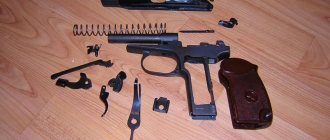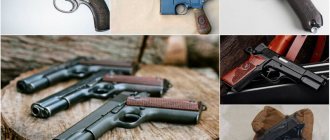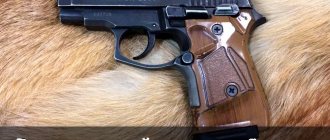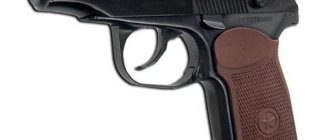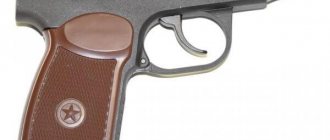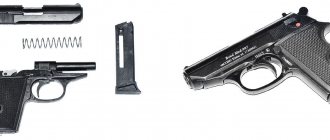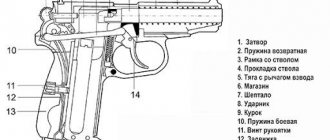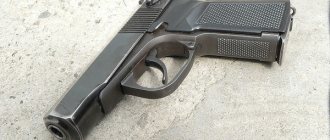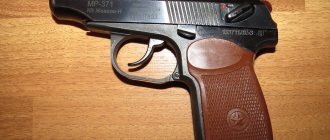What is a pneumatic?
The MP-654K air pistol is completely different in appearance from its prototype. The gas-cylinder version is known to many fans of pneumatic guns as a high-quality non-combat weapon with high mechanical strength. Despite its external similarity to its firearm counterpart, the MP-654K is not only a high-quality copy of the Makarov pistol, but also a completely independent pneumatic model. Weapons have been produced since 1997.
Features of the Makarov air pistol
The Makarov air pistol is a metal pistol. To fire a shot, the energy of compressed carbon dioxide is used. The store, as a rule, is combined, which houses a CO2 cartridge, as well as ammunition. Copper-plated steel balls or lead shot are used as ammunition. It is not advisable to use it, since due to the characteristics of lead, bullets can become jammed in the magazine, causing sticking and requiring disassembly of the model in order to correct the situation.
The Baikal MP 654k air pistol requires strict adherence to safety regulations.
Device
Since weapons-grade steel is used in the manufacture of the MP-654K, no other pneumatic gun can compare with this model in terms of strength. Non-combat weapons are equipped with a moving bolt. Since the MP-654K does not have a BlowBack function, you can only set the shutter delay manually. Firing is carried out both after preliminary trigger cocking and by self-cocking. The weapon is equipped with a magazine that has space for special steel balls and an 8-gram canister of CO2. It functions as an energy source.
Problems and repairs
Well, about the problems. Over time, the MP-654k develops a nasty problem - it stops firing by self-cocking. This sore is treated by replacing the trigger-cock mechanism. All parts are on sale. If your arms grow as expected, you can go through them in 40-50 minutes without rushing. And if your arms grow out of your butt, then these are legs, and you should not climb into an air gun with your legs. In this case, you need to put the gun in your pocket and go to the person whose arms are growing as expected, not forgetting to buy something tasty in a glass container along the way. As Cardan used to say: “So that your hands don’t shake.” * Digging off topic... There is an upgrade option that gives good results (according to the descriptions and estimates, I haven’t done it myself). In general, this up is for Drozd, but the valve mechanism is the same, so it will also fit the MP-654k.
Partial and complete disassembly
It is better to show incomplete and complete disassembly of the pistol visually, so we are attaching the corresponding videos.
Incomplete disassembly
Complete disassembly
Purpose
Since the legendary Makarov was used as a prototype for the pneumatic gun, the MP-654 has a design similar to a military weapon. This makes it possible to use the air pistol as a training pistol. Based on reviews from owners, we can conclude that the non-combat model is in great demand for those who want to practice the basics of handling weapons and hone their skills in assembling and disassembling a Makarov combat pistol. The MP-654 can also be used for recreational shooting and as a means of self-defense.
How to read an abbreviation?
To designate the group, type, serial number of the weapon and its modification, the developers provide special numbers and letters. Anyone who has decided to purchase an air pistol would do well to understand these symbols.
The letters and numbers MP-654K are used to indicate the manufacturer's name. In this pneumatic machine, the index MP (Mechanical Plant) means “mechanical plant”. The group of weapons is indicated by the first number “6” (pistol), the type of weapon is indicated by the second number “5” (gas-cylinder pneumatic gun). The last digit “4” indicates the number of this model in the group. The magazine version of the pistol is indicated by the last letter “K”.
On the left side of the pistol frame there is a set of numbers. Of these, the first two indicate the year of manufacture, and the rest indicate the model, series and serial number. If there is a letter “H” after these numbers, this means that this model is produced for export.
History of the creation of PM
The pistol, designed by Nikolai Fedorovich Makarov, was adopted into service to replace the TT, which did not meet the new army requirements for personal short-barreled weapons. During the Second World War, soldiers and officers of the Red Army gained extensive experience in the combat use of personal short-barreled weapons, both domestic and captured, of a variety of designs and manufacturers. The advantages, disadvantages and various features of most combat pistols of that time were identified. Including, clashes at short and extremely short distances, close battles in urban conditions showed the insufficient stopping effect of the bullet of the cartridge used in standard TT pistols, compared to the more effective 9 mm cartridges of the German Parabellums and Walters, as well as several significant shortcomings of the cartridge itself weapons. For example, the TT did not provide a sufficient degree of safety in handling due to the lack of a safety mechanism, in addition to the safety cocking of the hammer, which did not allow one to safely carry a pistol in full combat readiness at all times. The TT also had a fairly long length.
Its simple trigger mechanism worked only in single-action mode, while the best German captured pistols had a double-action trigger, which allowed the pistol to be safely carried with a cartridge previously chambered, and the owner of the weapon could instantly open fire. The need to develop and adopt a more advanced type of personal weapon that meets all the requirements of that time became obvious. And, in fact, officers preferred to go into battle not with a pistol, but with a much more effective submachine gun, using the service TT or captured Walter only when absolutely necessary, if the more effective weapon failed or simply ran out of cartridges. So, even during the war, it was decided to replace the Tokarev pistol with a modern model with higher combat and performance qualities. As a result, not only the requirements for personal weapons were revised, but also the overall concept of their use in the field army.
The new pistol was supposed to have smaller dimensions and weight, a trigger mechanism that allowed opening fire without first cocking the hammer, a greater stopping effect of the bullet, greater safety in handling and high reliability in difficult operating conditions. An experimental Makarov pistol was developed at the Tula TsKB-14 (later renamed TsKIB SOO) under the designation TKB-429, which exactly met the above requirements. At the beginning of the search for the best option and the early stage of development work, Makarov designed two versions of his pistol. One was chambered for the 7.65mm Browning cartridge, which gave the advantage of smaller dimensions and weight of the weapon, the other was chambered for the more powerful domestic 9x18. The 9x18 cartridge was created by engineer Semin before the start of the war. Its prototype was the German 9mm Ultra, developed by the German company GECO, however, having the same sleeve length, these cartridges are not interchangeable, since the bullet diameter of the domestic cartridge is 9.2 mm. In terms of energy and bullet speed, the 9×18 (official designation 57-N-181) occupies a niche between the 9mm Short and 9mm Parabellum, having a greater stopping effect of the bullet than the first and at the same time the ability to be used in blowback weapons, in comparison with second. The new Russian 9 mm cartridge was shorter than the standard 7.62x25, with a lower muzzle velocity and bullet energy, and less penetrating effect. However, due to the larger caliber, it not only had no less stopping power than the more powerful 7.62 mm cartridge, but even surpassed it in this quality. As a result, the choice was made in favor of the more effective 9 mm cartridge.
Makarov worked day and night to create his pistol. According to the designer’s recollections: “Suffice it to say that at that time I worked every day, practically without days off, from eight o’clock in the morning until two or three o’clock in the morning, as a result of which I modified and shot samples two or even three times more than my competitors, which, of course, made it possible to perfect reliability and survivability.” By choosing an automatic operation scheme using recoil energy with a free shutter, the designer made the weapon small-sized, relatively light, very reliable in operation, easy to maintain and inexpensive to manufacture. In general, the general layout and design of the components and mechanisms of the weapon were based on the solutions used in the German Walther PP, but at the same time Makarov significantly improved them in several areas: simplification of both the design itself and the handling and maintenance of the pistol; multifunctionality of parts; increasing operational reliability under extreme operating conditions; increasing the strength of parts and service life; increasing manufacturability and the pace of mass production. The recoil spring is located around the barrel, making the pistol more compact and lighter than designs that place the recoil spring under the barrel.
Makarov managed to almost completely eliminate delays in firing caused by sticking the cartridge into the feed ramp. The designer managed to achieve an ideal relationship between the height of the upper cartridge, the geometry and inclination of the chamber bevel, the shutter-casing mirror and the ejector design. With the PM, the upper cartridge in the magazine is located very high, almost at the level of the chamber, as a result of which, with the other above-mentioned features, the cartridges are fed at a minimum angle and the risk of sticking is minimized. The same Walter PP is very “picky” about the shape of the bullet of the cartridges used due to the low location of the upper cartridge in relation to the chamber. The reliability of the PM thanks to this design has been proven not only in tests, but most importantly, in real combat operations - in Afghanistan, Chechnya, and other countries where local soldiers fought and continue to fight. The hammer-type, double-action trigger mechanism with automatic safety cocking has a much simpler and more technologically advanced design. Descent with warning. The trigger pull when shooting with a pre-cocked hammer in single action mode is 2 kg, and when shooting self-cocking - 4.5 kg. The trigger parts are much stronger, more durable, and the mechanism itself is easier to maintain than that used in the PP pistol. The bolt stop lever is located on the left side of the frame.
The design of the Makarov PM pistol
On the left surface of the bolt-casing there is a safety lever, which, when turned on, blocks the firing pin and safely releases the hammer. In the on position, the safety locks the sear and the bolt-casing, while the trigger does not touch the firing pin. The PM fuse is an original design, significantly different from the Walter PP system, and the only significant similarity is its location. Makarov designed a fuse that is turned off by moving the lever to the lower position, that is, by a natural movement of the thumb of the shooter’s hand holding the weapon, while Walter’s fuse is turned off by moving the lever up. Sighting devices consist of a fixed front sight, made as part of the bolt-casing, and a rear sight, fixed in a dovetail groove with the possibility of making lateral corrections. The magazine latch is located at the bottom of the handle. The gun consists of only 32 parts.
The PM has good accuracy for a compact pistol. When shooting at 25 meters with standard 57-N-181 cartridges, the dispersion radius of the R100 is 75 mm, and at 50 meters it is 160 mm. At a distance of 10 meters, the dispersion radius is only 35 mm. It is necessary to separately note one of the design features of the PM - the multifunctionality of parts. For example, a double-leaf mainspring of complex shape, in addition to its direct and main purpose, also performs the function of a hammer release spring by bending its wide feather, and the lower end of the spring is a magazine latch. Some parts, especially the fuse, have a rather complex shape. But subsequently, a change in the production method made it possible to simplify and reduce the cost of the technological process. As a result, Nikolai Fedorovich created a pistol, which is an independent design with a number of original solutions, much more reliable, durable, simple and has a greater service life than the Walther PP taken as a basis.
F.V. pistols took part in the competitive tests. Tokareva, I.I. Rakova, P.V. Voevodina, S.A. Korovina, A.A. Klimova, GV. Sevryugin, S.G. Simanov and A.I. Lobanov, as well as foreign systems such as Walther PP, Mauser HSc, Sauer 38H, Beretta M1934 and FN Browning model 1910/22. The standard pistol was the standard TT. The most severe test was placing the pistols in a pit filled with a slurry of sand and water. In this case, Makarov’s sample demonstrated undoubted superiority in reliability. Pistol designed by N.F. Based on the results of tests in 1948, Makarov was recognized as the best, but it was recommended to make a number of changes to the design. After some modifications, the pistol was put into service under the designation PM (Makarov Pistol) in 1951. At the same time, after all the necessary work to improve and prepare for mass production, its production was launched at the Izhevsk Machine-Building Plant back in 1949.
It should be noted that during the initial period of production, work was carried out in parallel to improve and adapt the design of the pistol for mass production and to develop the most suitable technology. The plant's designers and technologists did a great job. Identified defects were eliminated, such as short service life, rapid settling of the mainspring and other shortcomings. As a result, the original version of the PM pistol underwent a number of changes, both internal and external. The experience of combat use in the army and law enforcement agencies testifies to the very high reliability and ease of use and maintenance of these weapons. Over time, shortcomings also emerged: a small stopping and penetrating effect of the bullet; small magazine capacity; a narrow handle, with a small angle of inclination like that of the TT - 102°, which does not provide full contact with the palm. Shooters with a low level of training or without regular training shooting with a PM do not demonstrate high accuracy, since its handle and somewhat peculiar “grip” need to get used to.
When shooting from a PM, especially when the bluing is erased, in side light the reflection on the front sight is perceived as the absence of its side part. As a result, the shooter turns the weapon in the direction of the light and the bullets fall away from the center. The presence of a manually controlled safety lever, which complicates the handling of the weapon, can also be considered a disadvantage of the weapon. However, at that time, the concept of personal short-barreled peacetime weapons dominated, that is, light, compact, convenient, possessing the necessary accuracy at short shooting distances and not burdensome for everyday wear. In the event of the outbreak of hostilities, personal weapons would no longer be very serious or significant on the battlefield. Therefore, the disadvantages of the Makarov pistol were not taken seriously into account, especially in comparison with its advantages.
The very first PMs were produced in Tula in a trial batch of 20 to 30 pieces. The numbers began with “TM”, followed by numbers and the year. After this, the production of Makarov pistols was moved to Izhevsk, where in 1949 a test batch of 5,000 copies was made, with numbers starting with “TM”. The frames of pistols of early production (1949 - 1953) are distinguished by a figured front part, and the trigger guard has a protrusion on the right side of the upper edge. The side protrusion of the trigger guard, when pulled down, opened access to the trigger, making it possible to remove it. In 1949, the pistol number was stamped on the rather wide front lower end of the bolt casing. In later versions, numbers were placed on the left side of the bolt casing and frame. The slide stop at the bottom had a release lever, also called a tooth. After the last cartridge was used up, the bolt-casing was placed on the bolt stop, and at the moment the loaded magazine was attached, the lever (tooth) of the bolt stop, interacting with the inclined protrusion of the window on the left side of the magazine, released the bolt-casing, sending the cartridge into the chamber. In order to ensure greater safety in handling weapons, the lever that automatically turns off the bolt stop was subsequently abolished. Now, in order to release the bolt casing with the magazine removed or attached, you need to press the outer protrusion of the bolt stop. Such a reduction in the combat qualities of the weapon, increasing the reloading time, is, of course, a controversial decision, but justified by the practice of operation in the army. The rear wall of the base of the handle of the PM frame produced in 1949 has a flat surface and does not have a bracket for clamping the mainspring, which is held directly by the handle and screw. Since 1950, the shape of the rear surface of the base of the handle has been changed due to the fact that the fastening of the screw holding the mainspring and the cheeks of the handle was constantly weakening.
MP-79-9TM_conversion from a combat PM: how to “identify” it in a store and how to determine the year of manufacture of the donor PM
In this video: 1) 5 practical tips on how to “identify” an MP-79-9TM, converted from a combat one 2) How to identify
,…
Comparison of the bearded PM SHP 1953 with the usual PM SHP
the PM as an example
-SO
1953
and
PM
-skh
1960
.
In 1950, production of the same shaped frames began, but with the base of the handle having a mount for the mainspring clamp bracket and the clamp itself. Pistols manufactured in 1949 were equipped with grip cheeks with a diamond-shaped cross notch on the back surface, the color of which could be either black or brown. Later ones have a smooth back surface, and only a red-brown color with various shades of it. From the second half of 1953, pistols with a modified trigger pull shape and reduced trigger free play began to be produced, as well as transitional models with a shaped frame, a bracket for clamping the mainspring, and a trigger guard that does not have a protrusion. In 1954, the configuration of the safety lever lever changed slightly. From the same year, production of a new type of frame began, with a thin front part, which is used to this day. In 1970, a reduced firing rate was adopted - from 5,000 to 2,500 rounds. In 1984, in order to ensure more convenient handling of the weapon, the number of notches on the left surface of the bolt casing was increased from ten to thirteen. Since 1988, the lever of the safety lever began to be manufactured using the method of casting in a mold and subsequent processing by milling. Around 1989 the quality of workmanship deteriorated. The shape of the bolt stop lever was gradually simplified. The hammer and trigger also began to be made using the same method. The shape of the front part of the trigger guard was changed, which in the 90s began to be made by casting. In 1993, production of pistols with a cast frame began.
One of the most important advantages of the pistol created by Nikolai Fedorovich Makarov is its reliability in the most difficult operating conditions. This quality has been proven not only in tests and during operation in the active army, but also in harsh combat conditions. The first major military conflict in which PM took part, in more or less significant quantities, was the Vietnam War. In the incredibly harsh conditions of war in the jungles of Southeast Asia, the Makarov pistol demonstrated excellent reliability. And then in Afghanistan, with minimal maintenance and sand, the PM worked flawlessly. In the First and Second Chechen Warriors, the Makarov pistol again proved its reliability, not letting down the soldiers of the Russian Army and Internal Troops at the right moment, when the cartridges in the machine gun magazine ran out, or they had to act in close combat. Former and current officers, veterans of the Afghan war and two Chechen companies, who had the opportunity to use their Makarov service pistol in battle, speak something like this: “In those conditions when both the pistol and your hands are all dirty, sometimes after a long absence of any care for weapons, I very much doubt that then some foreign pistol would not have failed, and the PM saved the lives of many of our soldiers.” Of course, when the chamber, the bolt-casing mirror, the grooves of the frame and the bolt-casing, and the ejector spring are heavily clogged with dirt, delays sometimes occur, but most of them are caused by careless handling of the weapon and other shortcomings due to the fault of the owner.
In the early 1990s, as a result of the collapse of the Soviet Union and a significant reduction in government orders for the army and law enforcement agencies, Izhmekh began producing export versions of the Makarov pistol for the civilian arms market. Such pistols were distinguished mainly by the presence of a rear sight adjustable in two planes and enlarged grip cheeks with protrusions for the thumb. By the mid-1990s. new PM variants were presented: IZH-70 chambered for 9×18 cartridge with adjustable rear sight; The IJ70-17A (IZH-70-200), whose production began in 1994, uses the 9mm Short (9×17) cartridge, and its variants IZH-70-100 (chambered 9×18) and IZH-70-300 ( under 9×17) are distinguished by magazines with a capacity of 10 rounds; in 1995, a service version of the PM, created for security structures, was released under the designation IZH-71 chambered for the 9×17 cartridge, produced in various versions, differing in magazine capacity and sighting devices.
In accordance with the Weapons Law issued in 1997, which regulated the use of firearms by private security organizations, Izhmekh launched the production of PM chambered for the 9x17 (9mm Short) cartridge, the bullet energy of which was 20% less than the standard 9x18 cartridge. Such weapons are classified as service weapons. One of the newest variants of the PM is the Baikal-442, which is a sports and training modification of the Makarov pistol chambered for 9×18. The main differences between this weapon and its prototype are the trigger guard with a front protrusion, a wider handle with a protruding diamond-shaped notch on the front and handle cheeks with side protrusions for the shooter’s thumb. Double-row magazine with 10 or 12 rounds. The handle width is 34 mm. As a separate order, it is supplied with a push-button magazine latch located under the slide stop lever and can be equipped with a laser target designator and a micrometric rear sight, adjustable in two planes.
In the Russian Federation, civilians, according to the Weapons Law, since the time of the Bolshevik coup, do not have the right to own short-barreled weapons, unlike many European countries and especially the United States, with civilized and democratic legislation, where Russian pistols are exported and they are relatively free ordinary citizens or those with a residence permit can buy. As a result, for the domestic market, the manufacturer of Makarov pistols and its various variants was forced to develop the following products based on the combat PM: the MP-654K air pistol of 4.5 mm caliber; gas IZH-79-8 and MP-79 chambered for 8 mm cartridge; traumatic 9 mm pistols Izh-79-9T “Makarych” and MP-79-9TM, as well as MP-80-13T chambered for .45 Rubber. Not taking into account the pneumatic pistol for sports training shooting and gas models, which have proven to be extremely ineffective for self-defense, the most popular are traumatic products that shoot rubber balls.
PM became widespread not only in the Warsaw Pact countries, but also in many countries friendly to the Soviet Union, and later throughout the world. Wherever the Makarov pistol was used, its highest reliability and simplicity were noted, as a result of which this weapon became very popular even in the presence of a large selection of much more modern ones and samples from leading arms companies in Europe and the USA. Makarov pistols, in addition to the Soviet Army and law enforcement agencies, were in service and manufactured under license in the GDR, Bulgaria, China and the Dominican Republic. After the unification of Germany, the production of PM was launched by the famous German weapons manufacturer - Simson. Despite all its advantages, by the end of the 1980s the Makarov pistol did not meet the requirements for a personal short-barreled weapon. Due to the widespread use of personal armor protection (PIB) in the armies of most countries of the world and the active activities of terrorist organizations, the weapon had to use a powerful cartridge with a high penetrating and stopping effect of the bullet and have high firepower. In order to create a new, more effective pistol, design work was launched at the “Rook” competition.
A temporary measure to solve this problem was the PMM pistol (Modernized Makarov Pistol) chambered for the 9×18 PMM cartridge with a reinforced powder charge and a lightweight bullet with a steel core and a cone-shaped head. The pistol itself differs from the prototype in the simpler shape of the bolt-casing, enlarged grip cheeks with side protrusions for the thumb, as well as a larger-capacity magazine with a double-row arrangement of cartridges. Compared to the PM, the PMM pistol has higher combat qualities, which, however, are inferior to their Western counterparts. 9x18 PMM cartridges are not interchangeable with standard cartridges and cannot be used in weapons chambered for the 9x18 cartridge. Due to some confusion, problems arose with breakdowns of standard PMs. The PMM is not widely used, and the PYa pistol, which won the Rook competition, cannot yet replace the PM due to financial difficulties. As a result, at present the Makarov pistol still remains a service weapon in the army and police. However, no matter what, the Makarov pistol combines the best qualities of a compact personal short-barreled self-defense weapon. It is compact, very reliable, durable, safe, easy to use and maintain. Despite the small, by modern standards, resource, some PM pistols, mainly produced in the 1960s. with the best workmanship, they have a very large shot and at the same time function reliably.
So the Soviet “Makarovs” in shooting ranges have a fire rate of up to 40,000 rounds. The average lifespan of the recoil spring ranges from 5,000 to 7,000 shots. Modern PMs, as a rule, cannot withstand more than 5000, since they, in fact, are not designed for this. Another example of reliability is that one owner of an old combat PM fired only about 52,000 shots from his pistol without a single delay. With proper experience and training, the pistol demonstrates excellent accuracy, even with standard grip cheeks. For example, the author knows the following result - when shooting at a distance of 25 meters with a series of five shots, when shooting with two hands at a low tempo, with Barnaul cartridges with jacket bullets, the maximum diameter of the group of hits was 60 mm! Even today, with a huge range of the latest and highly advanced models from leading manufacturers such as Glock, Beretta, Steyr, Walther, Smith Wesson and Sig Sauer, many people well versed in weapons choose the proven, trouble-free Makarov pistol to protect their lives.
Countless discussions have been held on the suitability of the Makarov pistol as a compact self-defense weapon. In these disputes, there are usually two dominant sides with opposing opinions. Those who consider the PM not a suitable weapon for such use, given the huge selection of the latest models, cite as seriously substantiated arguments the presence on the arms market of a huge selection of the latest models from leading manufacturers, which are ahead of the Makarov pistol not only in technical and technological terms, but also in the most important in this aspect of use qualities. As a rule, pistols with polymer frames, with double-row or single-row magazines are indicated as a comparison. Note that the length of the PM is 161 mm, and the width is 30.5 mm. Here it is necessary to give a couple of examples. New ultra-thin Walther PPS for 9mm Parabellum with a single-stack magazine for 6, 7 or 8 rounds, having the same length as the PM, but only 23 mm wide! Well-proven Glock 26 of the same caliber, with a double-row magazine with a capacity of 10 or 12 rounds, with a slightly shorter length and width than the PM.
Pistols such as the above are several times superior to the PM in terms of combat and performance qualities, and they all fire the more effective, most widely used 9mm Parabellum cartridges in the world. It is impossible not to agree with such arguments, especially when you know the features of each of the given pistols. Modern models of approximately the same dimensions are much lighter, much more convenient to hold and handle than the PM, and surpass it in shooting accuracy and firepower. Proponents of the advisability of carrying a Makarov pistol for self-defense point to its high reliability in extreme operating conditions and simplicity of design. Arguments are made that it is quite possible to learn to shoot from a PM with very good accuracy if you train enough, that it is quite convenient and not burdensome to carry it secretly, and the effectiveness of the cartridges used has been proven over decades of practical use in law enforcement agencies and the armed forces of Russia and the former USSR.
Even now, when Russian special forces have modern pistols, many prefer the old and proven PM, despite the relatively large length and insufficient smoothness of the trigger, greater weight than modern models and a slightly smaller magazine capacity. However, proponents of the PM generally agree that its cartridge is only effective if the enemy does not use personal protective equipment. After all, even inexpensive modern lightweight Kevlar body armor perfectly protects against PM shots. But here it should be clarified that employees of the Ministry of Internal Affairs do not encounter an enemy using NIB, and special forces soldiers have the opportunity to choose weapons for a more powerful and effective cartridge. But why today are Makarov pistols still in very stable and good demand in those countries of the world where citizens have the opportunity to choose any modern compact pistol, like those given as an example? This happens for several reasons. It should be clarified that Makarov pistols are most popular in the Baltic countries, other states that were formerly part of the USSR, as well as in Eastern Europe in general.
Many of those who purchase a Makarov pistol are former law enforcement officers and are very familiar with this weapon, having gotten used to it and having learned to shoot it well. The owner of a Makarov pistol about his weapon: “I have a German PM. Very good pistol! In terms of strength, in my opinion, it is not inferior to, and probably superior to, Izhevsk pistols from the times of the USSR. The quality of surface treatment and bluing is significantly higher than that of production from all those countries in which PM was produced. The finishing of the internal surfaces is excellent. There are no roughnesses or traces of mechanical processing. Firing accuracy is generally the same as that of most PMs.” However, the fundamental factor when purchasing a PM is not only its reliability, but also its low cost. A significantly more affordable price is often the decisive argument. At the same time, almost all leading experts in the field of personal weapons and their use, including the United States, point to an excellent combination of price and quality of the weapon itself. The Makarov pistol provides the buyer with excellent qualities of a compact personal weapon at a very affordable price.
For this reason, PMs are bought both in Western European countries and in the USA, where the level of well-being of the population is higher and people have the opportunity to purchase much more modern, but also more expensive weapons. Don’t forget about the huge selection of pistols in the USA. A resident of California about the popularity of PM: “Makarov is respected in America. I can judge because they don’t linger in our stores; they are quickly bought up, despite the availability of almost anything. I don’t know how it is in other states, it will only appear in our store, after 2-3 days it’s already taken away. In general, there is an opinion here that Russian weapons are reliable.” In addition, the owner of the PM about his pistol: “Of course, I got used to the PM for about two months until I shot it. But now I wear it every day. In the city, that's it. Small, 8 rounds in the magazine and one in the chamber, and most importantly, reliable. I'm not afraid that there will be problems with him. Psychologically, it is very important to carry a weapon that you trust.” The Makarov pistol, or as it is now called in the USA - Russian Mak, together with the Kalashnikov assault rifle in the West are the standard of reliable, functional, unpretentious, practical and effective weapons.
An employee of a special unit of the Ministry of Internal Affairs of the Russian Federation with extensive combat experience about the Makarov pistol: “Even despite its venerable age, it remains in service today and is actively used both in combat and at the shooting range. A classic pistol for civilian and police use. Of course, this is not a pistol for target or high-speed shooting, but placing three bullets in the center of a standard target (a circle with a diameter of 10 cm) is not a problem for this “old man”. He is capable of more. Some of our PMs allow you to place five holes in a 6 cm circle. As for the low stopping effect of a bullet, I can say that this is said by individuals who, at best, kill paper targets, and have never fired in a combat situation. It is important to hit the vital organs of the “target”, otherwise even a rifle bullet will not guarantee a reliable hit. Some problems are caused by bullets with a steel core Pst, which sometimes ricochet off solid obstacles. In recent years, the situation with ammunition for PM has changed; cartridges with bullets with increased stopping power and increased penetration have appeared. For example, the PPO cartridge for law enforcement agencies allows the use of weapons (pistols and submachine guns) in enclosed spaces, in populated areas, with a low probability of dangerous ricochets, due to the absence of a solid core in the bullet. There is information about the poor quality of PPO cartridges and unstable characteristics, but the cartridges supplied to our unit do not present any unpleasant surprises and the weapon works with them like clockwork...”
Another significant reason for choosing the PM over other pistols in this price category is also the historical value of the Makarov pistol. As, for example, TT or Mosin rifles. But the PM is still, first of all, a reliable compact combat pistol for constant wear in the city, and judging by the reviews, the people who bought it for this purpose are quite satisfied with their purchases. Owners who have appreciated the advantages and qualities of these Russian pistols, including prominent journalists who write articles on weapons for the largest American periodicals on this topic, advise the PM as one of the best options for concealed carry in the class of inexpensive compact models. Currently, not only pistols made in Russia or the former USSR, but also Bulgarian ones or those produced in East Germany are widespread on the arms market. Many experts rate German Makarov pistols as even higher quality than those manufactured in the Soviet Union. Old PM, produced by IZH, before the early 1990s, are especially valued. Such pistols are valued as collector's weapons, but they are also used for carrying and for sport shooting. Currently, the PM remains one of the most popular combat pistols in the world.
MP-654K series
Since 1997, the basic model of the air pistol has been constantly modernized. Today, the following modifications are available on the shelves of gun stores:
- The Makarov MP-654K air pistol is basic. It was produced from 1997 to 1999. A characteristic feature of this version is the unsuccessful valve design. As a result of poor assembly, this pneumatic gun needed serious repairs after a hundred shots.
- MP-654K-02 first appeared in 1999. It was a product with laser engraving, white or yellow titanium coating of hammers, triggers, safeties and bolts. This pneumatic gun is still on sale today. The set includes wooden grips for the handle, for the manufacture of which valuable types of wood are used. The product is a gift model and is made primarily to individual order. To decorate gift pistols, various engravings and decorations are used in the form of decorative elements: flags and coats of arms, gilding of parts. These pneumatics are sold in beautiful gift cases.
- MP-654K-03 was produced until 2010. The product is a modified version of the 654 model. Among consumers, this pneumatic gun is one of the most famous and widespread. These pistols were equipped with extraction windows that had both an oval shape and special cutouts for the extractor tooth. This version is sold in plastic cases.
- MP-654K-11 version has been produced since 2010. A characteristic feature of the product is a special camouflage coloring “autumn foliage”. According to some consumers, this coating gives the weapon a toy-like and frivolous appearance.
- A characteristic feature of the MP-654K-15 version is the presence of a false silencer - a detachable simulator of a device for silent shooting. For its installation in the barrel channel of the pneumatic gun there is a special thread. The false silencer consists of a metal tube. It is completely useless for reducing sound. Although the muffler simulator in this model is just a skillfully executed decoration. Some owners use it as a barrel extension, giving the steel ball additional acceleration. In their opinion, high initial speed and accuracy are achieved precisely due to the presence of a false muffler.
- MP-654K-24 is a nickel-plated version of the 654. The pistol is completely white. The handle is black.
- Also in this version, you can find a two-color pneumatic gun on gun counters: the body and handle are black, and the bolt and other control parts are white with a nickel plated finish. Among airgun enthusiasts, this premium model 654 is a very popular and quite rare weapon. These pistols can be either classic black or nickel-plated: the body and bolt are white, and the handle is dark, made of precious wood. A special feature of the premium model is the presence of gold plating on the controls. All guns are equipped with open clamping screws.
- MP-654K-28 has been produced since 2012. Externally, this pneumatic gun is very similar to the combat prototype. The pistol of this modification is equipped with an inflated bolt stop and a hidden clamping screw. A stiffer spring is provided for the ball feeder. Due to the narrow plastic handle, according to the owners, this modification of the 654 is very inconvenient to hold. A superficial visual inspection may lead to the impression that this handle was taken from a real combat PM. But this is not so, since the handle of the Makarov pistol does not correspond to the size of the MP-654K-28 frame. According to reviews from owners, the material from which the handle is made is of very poor quality. In addition, it is not provided with a swivel - a safety cord for the pistol. If desired, such a handle can be replaced with a similar textolite, bakelite or wooden one.
- MP-654K-32, or the “three hundredth” model. The product is equipped with a bakelite handle and a curly bracket. The absence of notches on the handle is one of the features of the MP-654 version 32. The bolt is equipped with a beard, a chamfer and a cutout for the extractor. The weapon has a neatly machined trigger and a wide rear sight. According to many consumers, in this version of the 654 the barrel is bored much more accurately than in previous models. The presence of rifling in the barrel makes it difficult for the steel balls to move, which ultimately negatively affects the accuracy of fire. Many owners, after purchasing this version of the pneumatic gun, first of all replace the rifled barrel with a smooth one. Initially, the manufacturer welded the barrel to the frame, which made such a replacement significantly more difficult. Today, trunks are no longer welded, but screwed.
Price list with prices for pneumatic repairs:
- Diagnostics of technical condition from 150 rub.
- Installation of a swivel from 300 rub.
- Replacing the front sight on rifles from 300 rubles.
- Cleaning and lubrication of the gun from 200 rubles.
- Cleaning and lubricating the rifle from 400 rubles.
- Minor repairs of pistols from 200 rubles.
- Stock replacement from 400 rub.
- Sighting from 250 rub.
- Minor rifle repairs from 500 rubles.
- Replacement of a screw, gas spring from 1000 rubles.
- Power boost from 500 rub.
- Replacement of piston cuff from 800 rub.
- Replacement of a set of gaskets from 400 rubles.
- Replacement of gearbox, valve needle for PCP from 1200 rub.
- Repair, assembly of USM from 500 rub.
- Re-preservation of pneumatics from 800 rub.
- Installation of optical and collimator sights from 400 rubles.
- Replacement of gaskets in CO2 guns from 450 rubles.
- Adjustment and repair of the store from 1200 rubles.
- Repair of USM pneumatics and all types of pistols from RUB 1,500.
- Elimination of undershooting and sticking (pistol) from 1500 rub.
- Optical sight zeroing (according to LHP) 10m from 800 rub.
- Gun cleaning from RUB 1,150.
- Removing stuck bullets from RUB 900.
- Measurement of bullet departure speed from 150 rubles.
- Enlargement of the passage pupil RUB 1,600.
The site lists only a small part of the work that we perform daily. The exact cost depends on many factors: how complex the breakdown is, whether this part is in stock or needs to be ordered, on the complexity of the design and condition of the weapon, etc.
Additional information about the MP-654K-32 air pistol, its structure and warranty service can be found on the manufacturer’s official website.
Stages of repair of MP-654K-32:
- Call the service center or write to us by email. Describe the problem, indicate the model of your rifle or pistol.
- The technician will advise you on the approximate cost of repairs and invite you to the service center.
- In the workshop, after diagnostics, the exact price and time frame for completing the work will be given. Which agree with you.
- After completing the work, the master will contact you and you can take your air gun home.
Model features:
This is a pneumatic analogue of the Makarov pistol with a working part made of weapon steel, a bakelite handle and a curly brace. The barrel is rifled, the pusher system is gas-cylinder, the tension screw is hidden. Disassembly is the same as for the combat counterpart. pneumatic pistol (PM, Makarova) shoots explosive balls (caliber 4.5 mm). When assembled, its weight does not exceed 730 g.
The presented air pistol MP-654K-32 is an ideal copy of the Makarov firearm. The characteristics of the model are almost the same as the previously released version MP-654K. Its advantages are high quality of individual parts, reliability of assembly, durability, and ease of use.
The 32 series of pistols, the so-called 300 series, is equipped with a bakelite (black from 2022) grip and a figured trigger guard from the same military older brother. The MP-654K-32 pistol has a hidden tension screw, which makes this pistol practically indistinguishable from its combat counterpart. The appearance of the presented pistol greatly simplifies tuning and improvement of the device, which has no rules and boundaries.
Purchasing this pistol will allow you to learn basic skills in handling weapons. Disassembly (incomplete/complete) is no different from that on the combat counterpart. A clear difference between the pistol is its trouble-free operation and durability, since the main material of the product is weapon-grade steel. MP-654K-32 is an unsurpassed gift for a man of any age and lifestyle.
The pneumatic analogue of the legendary Makarov MP-654K-32 is a pistol with a gas pusher system. Weapon-grade steel, which is the main material for parts when creating the model, makes the weight of the pneumatic indistinguishable from the weight indicators of a real “PM” . This model will be an excellent option for acquiring the skill of shooting at moving and non-moving targets. The technical indicators and characteristics of this model have earned the trust of not only beginners, but also professional weapons experts.
The most important advantages of the MP-654K-32 can easily be attributed to the ideal quality of individual parts and assemblies, the most reliable almost jewelry assembly, resistance to impacts and, of course, the long-known practical design.
In addition to all of the above, all pistols of the 300 series, like the combat model, are equipped with a bakelite handle and a figured trigger guard. The weight of the assembled pistol is no more than 730 g. The energy source for firing a shot is a cylinder filled with compressed carbon dioxide.
Series for export
The MP-654K-32N model uses an unhidden clamping screw and a bent bolt stop. As in the “three hundredth” model, the MP-654K-32N used welding to attach the barrels. In later products for export, the barrels began to be screwed to the frame. They are also equipped with internal threads. According to the owners, the advantage of this version of the pneumatic gun is the presence of small and completely invisible serial number markings, etc., which are not noticeable and do not spoil the overall impression. The disadvantage of the “five hundredth” model is the lack of a sealing gasket between the barrel and the magazine. Complete sealing can be achieved in this pneumatic device only if the barrel is completely adjacent to the magazine.
